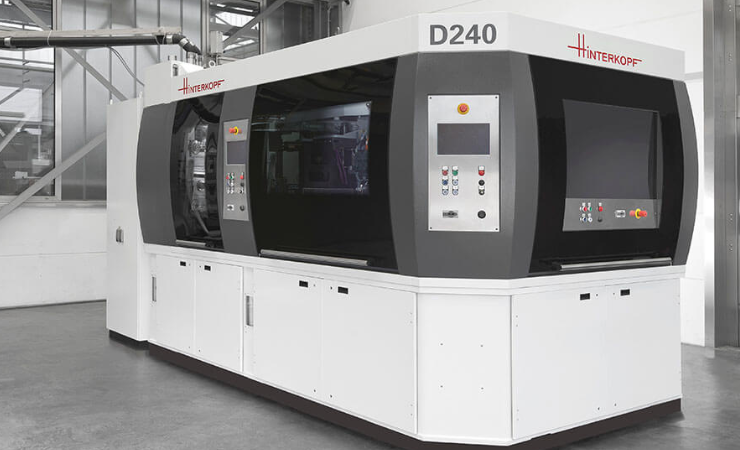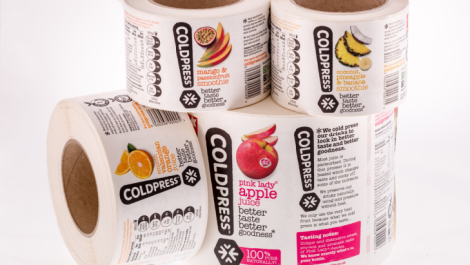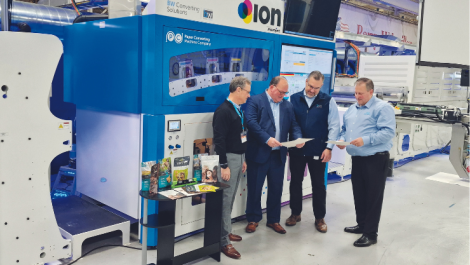As Sean Smyth writes in latest column for Digital Labels & Packaging, after years of development and a handful of false starts, direct-to-shape digital printing looks set to gain genuine traction going forward.
A perennial topic in digital packaging has been the potential for direct-to-shape (DTS) printing of rigid packs and shapes.
Equipment developers claim their technology provides a cost-effective alternative to labels, offering greater agility by printing containers closer to the filling lines. Eliminating labels can deliver a sustainability benefit, provided the pack can be de-inked successfully. There are many suppliers developing direct printing systems, with 3Sixty, Acelorex, Hapa, Heidelberg, Inkcups, Krones, LSinc, Machines Dubuit, O&PM Europa, Tonejet, Velox and Xerox just a few examples of the growing supplier pool for DTS technology. Not all systems are solely aimed at packaging, as many can be used to decorate objects from cups to chainsaws.
Most are low performance machines, producing samples or very short runs. They use non-impact inkjet with either UV curing or water-based inks. Tonejet, for example, uses proprietary electrostatic concentration method to print onto cans.
False dawns
Tonejet has now sold a couple of its Cyclone printers, although take up has been slow. To further example this, prior to the Covid-19 pandemic I visited the AB InBev bottle printing facility, just outside Leuven in Belgium. The company had made a significant investment in direct-to[1]bottle printing using DecoType UV printing technology from the Dekron subsidiary of Krones. A campaign for Becks was printed using this system but there were few others and the facility is no longer operational.
I enjoyed the visit, but several things just did not add up. Most of the space was taken up by storage and conveyancing systems for empty bottles, which arrived on trucks in crates and had to be unloaded, stored and then individual bottles loaded onto the conveyors. These went to pre-treatment stations where they were washed, flame treated and a primer applied, giving a 10-minute window for printing. The Krones Dekron modular system was capable of handling hundreds of bottles every minute, printing white and process colours onto the bottle body. The print was cured, then bottles conveyed to be re-crated and shipped off for filling. My host expressed concerns about the viability of the operation in terms of response and cost when compared with a simple label application at the filling line. Different bottle forms required special tooling. Brewers were unwilling to print onto filled bottles because of the danger of skunking the beer – most beer uses green or brown bottles to shield UV light that can cause an adverse chemical reaction. This generates 3-methyl-2-butene[1]1-thiol, a substance like the stuff a skunk sprays when it is cornered, which sounds unpleasant. There were also concerns about the recyclability of the empty printed bottles, so not a great endorsement of the real benefits for high volume bottle printing from a leading brand.
Owens Illinois also installed a similar system at a factory in France where it offered digital printing and embellishment as OI Expressions. Providing high build printing as a cost[1]effective alternative to using a special mould to produce embossed bottles for limited runs, this is still an offer for customers. Koenig & Bauer Kammann has several digital machines at glass printing customers.
Springboard
German engineering company Hinterkopf is probably the market leader for high volume systems with over 20 of its D240 series of digital printers now in the field. The first applications were used to print rigid plastic tubes, for adhesives and sealants that are applied using a caulking gun. They then developed systems to print onto glass and two-piece aluminium cans. In late 2022, Oasthouse Engineering installed the first D240 machine in the UK as part of a £3 million investment at its headquarters in Rotherham, where digital print services with lower minimum order quantities and fast turnround are now offered. Customers are in the craft brewing sector but owner and operations manager Samantha Morris highlights some new applications, including meat, fish and vegetable stock that are now sold in cans. ‘We want to print a significant proportion of the 60 million cans we sell each year, and this technology will let us do that,’ she says. ‘The EU has placed bans on sleeves and labels that can hinder recycling efforts and may be covered in single-use plastic bans, meaning we will not be able to apply sleeves. Our minimum order quantity will be one printed can and we want to help our small but fast-growing customers get their high-quality products into the market.’
Global consumption of cans topped 400 billion in 2021. The great majority were printed using dry offset, in the round at the can manufacturing stage, with a protective coating. For short runs, some cans have a self-adhesive label applied or more commonly a shrink sleeve and there is a small proportion digitally printed. After Covid-19 boosted home consumption, the can market has seen increased demand with some of the leading players increasing their minimum order quantities as they supply to major brands. Last year Ball Corporation announced its minimum order quantity would increase to 1.03 million 330ml cans, which is five truckloads. This is strange as much of the growing demand was from the craft beer and drink sectors, looking for much lower runs.
The first user of Hinterkopf technology in North America was Hart Print, a Canadian business based in Quebec. Founded in 2018 as a purely digital can printer, the company was bought by Ardagh Metal Packaging in 2021. There are plans for a second facility at Glendale Heights in Illinois near Ardagh’s technical centre. Ardagh is one of the biggest can producers globally and states, ‘This initiative enhances our ability to serve fast-growing, emerging customers as they seek to access the market. It enables us to respond flexibly to larger customers’ shorter run requirements, including for new product introductions and targeted promotions.’
In July 2022, a public announcement from Ball Corporation declared, ‘Digitally-printed beverage cans will be available to Ball’s customers in Brazil as the canmaker meets demand for customisable labels, faster turnaround times and smaller minimum order volumes.’ This announcement came as the company has invested in SLAC International technology as it scales up pilot plant operations.
In 2021 Crown Holdings announced a collaboration with Velox, an Israeli developer of direct-to-shape digital decoration systems, to provide brands with digital decoration technology for both straight wall and necked aluminium cans. Crown installed a machine at its Wantage development facility to explore the capabilities, to unlock new possibilities for major brands wishing to increase product offerings, as well as smaller producers taking advantage of the benefits of fully recyclable beverage cans. The Velox technology offers print speeds of up to 500 cans per minute with the capability to print necked cans with up to 14 colours and embellishments such as gloss, matte and high build across the surface of a can.
These are significant developments because Ardagh, Crown and Ball are the three largest can manufacturers in the world. They have the resources to investigate the technology properly, to see if it will remain an interesting niche or move the mainstream packaging. The links with these companies give a major boost to direct-to-shape to provide credibility for the technology. The individual companies are gaining guidance to develop their systems for high volume production, ensuring quality, reliability and response meet the brand requirements.
It may well be that these relationships are a springboard to more widespread adoption of high-performance printing systems for mainstream packaging.
This article was first published in issue 1 (Jan/Feb) 2023 of Digital Labels & Packaging, which can be read online; register here for all future issues of the magazine






